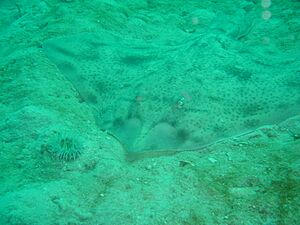Biscuit skate facts for kids
Quick facts for kids Biscuit skate |
|
|---|---|
 |
|
| Conservation status | |
| Scientific classification | |
| Genus: |
Raja
|
| Species: |
straeleni
|
The biscuit skate, also known as the false thornback skate or spotted skate, is a type of fish that lives in the ocean. It belongs to the skate family, which are flat fish related to sharks. You can find this skate in the eastern part of the Atlantic Ocean.
Contents
What Does the Biscuit Skate Look Like?
This skate has a flat, wide body that looks a bit like a diamond or a kite. It has a short, blunt nose and a long, thick tail. Its "wings" are actually its pectoral fins, which are very wide and flat.
Biscuit skates are usually light brown. They have cool black spots, swirly patterns, and round shapes on their backs. Look closely, and you might see a dark brown "eye spot" near the base of their fins, though young skates don't have these. Their top side is covered in many small, sharp spines, like thorns. There's also a line of stronger thorns running down their back and tail. Older skates might even have thorns on their white underside! They can grow to be about 68 centimeters (27 inches) wide.
Where Do Biscuit Skates Live?
You can find the biscuit skate in the eastern Atlantic Ocean, all the way from Western Sahara down to South Africa. These skates are "oceanodromous," which means they travel long distances in the ocean. They are also "demersal," meaning they live near the bottom of the sea.
Biscuit skates can be found in both shallow waters near the coast and in very deep areas, up to 800 meters (about 2,600 feet) deep. However, they are most often seen at depths between 100 and 300 meters (about 330 to 980 feet). They really like sandy areas, including calm bays and the edges of the continental shelf.
How Do Biscuit Skates Live?
Biscuit Skate Behavior
These skates like to move around! During warmer times of the year, they swim closer to the coast into shallower waters. When winter comes, they head back to deeper, warmer parts of the ocean. Most of the time, they lie flat on the sand. This helps them hide from predators because their spotted brown bodies blend in perfectly with the seafloor.
What Do Biscuit Skates Eat?
The biscuit skate is a carnivore, meaning it eats other animals. Its diet mainly includes small ocean creatures without backbones, like crustaceans (such as crabs and shrimp). They also eat smaller bony fish and even leftover bits of fish from other animals.
How Do Biscuit Skates Reproduce?
Biscuit skates are "oviparous," which means they lay eggs. Their egg cases are dark brown and have special horn-like parts on their shells. These egg cases protect the developing skate inside until it's ready to hatch.
Why Is It Called That?
The scientific name for the biscuit skate is Raja straeleni. "Raja" comes from a Latin word for a stingray. The "straeleni" part was chosen to honor V. Van Straelen, who was the director of a museum in Belgium called IRSNB.
Why Are Biscuit Skates Important to Humans?
People catch biscuit skates for different reasons. They are caught by commercial fishing boats and also by people who fish for sport from shore or from boats. The "wings" of the skate (which are actually their pectoral fins) are often sold as food.
Conservation Status of the Biscuit Skate
The IUCN has listed the biscuit skate as "Near Threatened." This means that while they are not in immediate danger, their numbers could become a problem in the future.
In some areas, like South Africa, the population seems to be stable. However, in the northern parts of their range, there's a lot of fishing happening that isn't managed well. This, along with fewer skates being caught and fishing boats having to go further out to find them, suggests that their numbers have dropped a lot in some places because of too much fishing. It doesn't help that these skates reproduce slowly, making it harder for their populations to recover quickly.



